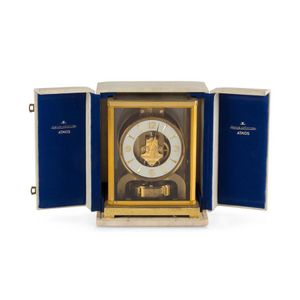Eiffe Chronometer No. 469 with Provenance
You must be a subscriber, and be logged in to view price and dealer details.
Subscribe Now to view actual auction price for this item
When you subscribe, you have the option of setting the currency in which to display prices to $Au, $US, $NZ or Stg.
- Maintaining Power - A horological term to describe a subsidiary driving force such as a spring or additional weight in a clock, which keeps the movement going while the mainspring is being rewound.
- Mahogany - Mahogany is a dense, close grained red-coloured timber from the West Indies and Central America. It was first imported into Europe in the the early 18th century and its use continued through the 19th century. It was popular for furniture making because of its strength, the wide boards available, the distinctive grain on some boards, termed flame mahogany and the rich warm colour of the timber when it was polished.. The "flame" was produced where a limb grew out from the trunk of the tree, and this timber was usually sliced into veneers for feature panels on doors, backs and cornices.
Some terms used to describe mahogany relate to the country from which it originally came, such as "Cuban" mahogany, "Honduras" mahogany etc. However unless the wood has been tested the names assigned are more a selling feature, rather than a true indication of the timber's origin. - Circa - A Latin term meaning 'about', often used in the antique trade to give an approximate date for the piece, usually considered to be five years on either side of the circa year. Thus, circa 1900 means the piece was made about 1900, probably between 1895 and 1905. The expression is sometimes abbreviated to c.1900.
- Thomas Earnshaw Balance Springs - Thomas Earnshaw (1749 ? 1829 )was a British clock and watch maker who was a renowned inventor and craftsman. Earnshaw is credited with standardizing the design of the marine chronometer, making it a more reliable and accurate instrument for navigation. He also developed a process for hardening the balance springs used in chronometers, which made them more durable and resistant to temperature changes.
- Ivory - Ivory is a hard white material that comes from the tusks of elephants, mammoth, walrus and boar, or from the teeth of hippopotamus and whales. The ivory from the African elephant is the most prized source of ivory. Although the mammoth is extinct, tusks are still being unearthed in Russia and offered for sale.
Ivory has been used since the earliest times as a material for sculpture of small items, both in Europe and the east, principally China and Japan.
In Asia ivory has been carved for netsuke, seals, okimono, card cases, fan supports, animals and other figures and even as carved tusks.
In the last 200 years in Europe ivory has been used to carve figures, for elaborate tankards, snuff boxes, cane handles, embroidery and sewing accessories, in jewellery and as inlay on furniture. Its more practical uses include being used for billiard balls, buttons, and a veneers on the top of piano keys.
The use and trade of elephant ivory have become controversial because they have contributed to Due to the decline in elephant populations because of the trade in ivory, the Asian elephant was placed on Appendix One of the Convention on International Trade in Endangered Species (CITES), in 1975, and in January 1990, the African elephant was similarly listed. Under Appendix One, international trade in Asian or African elephant ivory between member countries is forbidden. Unlike trade in elephant tusks, trade in mammoth tusks is legal.
Since the invention of plastics, there have been many attempts to create an artificial ivory - Movement - The technical name for the workings of a clock or watch, and does not include the dial or case.
- Fusee - The fusee movement was used in clocks and pocket watches from the mid 17th century. The fusee is a cone shaped drum within the works that is linked to the barrel of the spring, usually by a length of chain.
As the mainspring loses its tension over time, the cone shaped barrel compensates for this by increasing the tension, by pulling the mainspring tighter, thus ensuring the time remains constant.
Use of the fusee in clocks was superseded by the "going barrel" in the mid 19th century and for pocket watches at the beginning of the 19th century.
The fusee continued to be used in marine chronometers until the 1970s. - Manner of .... / Style of ..... - A cataloguing term where the item, in the opinion of the cataloguer is a work in the style of the artist, craftsman or designer, possibly of a later period.
This item has been included into following indexes:
Visually similar items

A blackwood two day marine chronometer, retailed by Thomas Gaunt, Bourke Street, Melbourne, 1880, the silvered dial Roman numerals, fuse movement with maintaining power Earnshaw's spring, detent escapement with compensation balance and helical hair spring,

An English rosewood cased two day marine chronometer, circa 1860 the silvered dial signed John Poole, maker to the Admiralty, Fenchurch St., London. no.2251, subsidiary seconds and up-down gimbal, mounted within three tier rosewood case with original ivory

A Jaeger le Coultre Atmos clock, Swiss, 20th century, with original case and papers, 22.5 cm high

A marine Chronometer A. Johannen Co. London, Makers to the Admiralty and to the Royal Navies of Spain & Portugal, no. 3651 anti-clockwise with a ratchet movement, boxed in brass bound timber, glass top and velvet upholstery to interior of lid, accompanied
